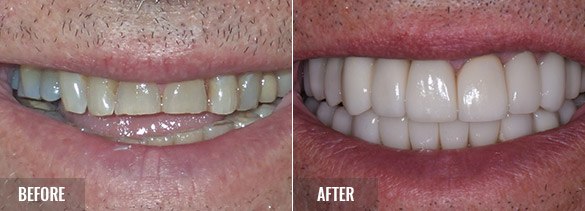Sometimes, damage can occur to your teeth no matter how well you take care of your teeth with brushing and flossing and regular dental visits. Grinding and clenching, old dental restorations, decay, injuries, and other issues can all lead to the need to restore and protect a damaged tooth. In many cases, dental crowns, also frequently called “tooth caps,” are an economical and effective way to do just that.
Dental crown options
At Lepore Comprehensive Dentistry in Dunedin, Florida, Drs. Ryan Lepore and Erin Dougherty provide patients with custom-designed crowns for a healthy tooth that blends seamlessly with your smile. Several different materials are available to fabricate your crown: for example, crowns can be made from all porcelain, porcelain that is baked onto a metal framework, or one of the modern dental ceramics that offer strength and beautiful aesthetics. Typically, all-porcelain crowns at used at our office.
In addition to protecting and restoring a damaged tooth, dental crowns can be used for various reasons, such as replacing a missing tooth on top of a dental implant, anchoring a dental bridge in place, or for cosmetic issues such as permanent discolorations or stains. Dental crowns are typically indicated over fillings when more than 50% of the tooth’s structure is compromised due to already large fillings, extensive tooth decay, or recurrent decay under old fillings.
Crown vs. Filling:
When a tooth’s structure has been compromised by decay, your doctor may choose to use a filling or a crown to repair it. There are some differences between the two solutions that you will want to discuss with your doctor as you plan your treatment.
When repairing a small area of decay, a filling is a great option to replace the damaged portion of the tooth while preserving the majority of the tooth’s natural structure. The cavity can be filled with a material called composite.
Composite closely mimics the tooth’s natural shade and sheen. Once completed, the filling should halt the decay and keep the tooth healthy for a number of years. Additional benefits of a filling include the ability to be completed within a single appointment and lessened cost compared to a crown.
However, a drawback of a filling can be a shorter comparative life span for the restoration, and potential long-term issues like recurring decay and cracking can occur.
The risk of cracking is increased as the area needing to be replaced gets larger. When the tooth cracks, a more extensive procedure will be required to return the tooth to optimal shape and function.
Another option is placing a crown over the tooth. This is the best treatment when a tooth has been weakened by extensive decay, injury, or deterioration of a large filling. A crown procedure involves reducing the surface area of the whole tooth to remove the decay and then covering it entirely with a restoration made of metal, ceramic, or a combination of the two. Crowns offer better durability and reliable longevity compared to a large filling and eliminate the potential for teeth developing fractures over time. Also, when ceramic is used, they provide a much more uniform and naturally pleasing appearance. This procedure is more involved than receiving a filling and can require multiple appointments if molds are sent to an outside lab to create the crown. While also more expensive than a filling, the durability and reliable longevity of a crown offsets this expense over time.
In the right circumstances, both a filling and a crown are excellent solutions for repairing decayed or damaged teeth. It is important that you consult with your doctor so that the right choice can be made based upon your unique needs.
Placing a dental crown
To place a dental crown, Dr. Lepore or Dr. Dougherty will consult you to determine the best options for your specific treatment plan, such as which material will be used for your crown. Then, he will perform the following steps:
- Shape the tooth to prepare it for the crown so that the crown has a natural fit and function within your mouth and bite
- Take impressions of the tooth so that the crown can be custom-fabricated by his expert dental laboratory.
- Once the crown is ready, Dr. Lepore or Dr. Dougherty will check the fit and adjusts it as needed before cementing it into your mouth with a strong dental cement
When a tooth’s structure is compromised, a crown rebuilds the tooth to optimal shape and function. A crown can be metal, ceramic, or ceramic covering metal. It typically requires multiple appointments to complete the process of getting a crown.
At the first appointment, your doctor will take an impression or a mold to help make a temporary crown for your tooth. Next, the tooth is prepared to make room for the crown. Your doctor will take another impression of the prepared tooth and put in a temporary crown while your final restoration is being expertly constructed by a dental laboratory.
At a subsequent appointment, your doctor will remove the temporary crown and replace it with the final restoration.
Once completed, your tooth is now restored to ideal shape and function.
The right dental care for you
A one-size-fits-all approach rarely works, and when it comes to dentistry, Drs. Ryan Lepore and Erin Dougherty understand that personalized, custom care is essential to your oral health and wellness.
To learn more about the options that are a good fit for your dental needs, call Lepore Comprehensive Dentistry in Dunedin, FL, today at (727) 608-4690.

Request an Appointment











